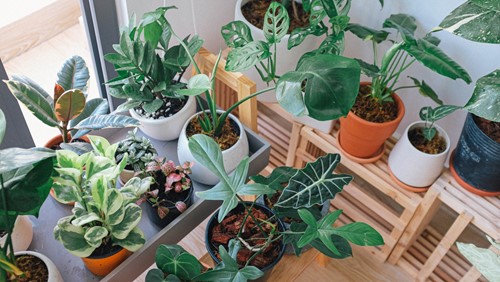
Plant owners have likely encountered the term "bottom watering" concerning houseplant care. The method works by watering your plants using the drainage hole at the bottom rather than pouring water in from the top. There are many benefits to bottom watering, but there are also some downsides worth considering. Here is a basic guide to the pros and cons of bottom-watering your plants:
Pros
Avoid Excess Surface Moisture
Some plants benefit from bottom watering because it keeps excess water away from the leaves. Succulents, for example, can wither or mildew if their leaves are exposed to water for too long. Other plants with tender foliage like inch plants and peperomias will also suffer if water is allowed to sit for too long on the leaves. Bottom-watering removes this issue entirely.
Strengthen Roots
Bottom watering can strengthen and encourage root growth. As the moisture saturates the soil through the bottom of the pot, the plant's roots will actively try to get to it. While a slow process, this "reaching" behavior can benefit the plant in the long term and speed up its growth.
Plants Control Their Intake
While it's still possible to overwater from the bottom, it's far less likely to happen as the plant will simply stop absorbing water when it's had enough to drink. The opposite is also true: an extremely dry and thirsty plant will absorb water quickly, which can tell you about its regular water needs.
Cons
Very Slow Process
Bottom-watering takes a long time. For a plant in a standard 6-inch growers pot, you may need to let it sit in water for over 30 minutes depending on the potting mix you use. Some plants are slow drinkers and require an hour or more for adequate watering.
Inconvenient in Small Spaces
You need shallow vessels for your plants to soak in, which can take up precious space. Some plant owners get around this problem by filling the kitchen sink or even the bathtub with water and placing several plants together at once. While efficient for the plants, it's inconvenient for the humans.
Bottom watering is a favorite method of many houseplant owners, but it's certainly not required. Consider these points when deciding how best to water your own plants.
About the Author

Rudden|Bobruska Team
Gary Rudden, Lisa Rudden, and Nick Bobruska
RUDDEN BOBRUSKA TEAM
What sets your team apart from other real estate teams?
There is no team out in the market that offers what we do. All of us are Realtors, but
we each have specialized roles, which make our team so unique!
After decades of living and selling real estate in the DMV, we have established
ourselves as one of the top real estate teams with our market expertise and
cutting-edge technology. Our savvy high-tech marketing is on every website
and social media source. We have a huge network with other top agents, which
helps to premarket homes and discover homes for buyers before they reach the
open market. Our services include professional in-house staging services, broker
expertise in negotiating and navigating contracts, and buyer representation in all
price ranges. Each client has different needs and we create a marketing plan based
on those needs.
Our most distinct feature is our in-house construction and renovation team. We
are literally a full-service, one-stop shop when selling or buying a home!
How does the in-house construction and renovation team work?
All work is managed and completed through our licensed and bonded construction
crew. No need to call outside contractors. We are like “HGTV,” but we just don’t
have a show! Whether it’s a small makeover or a major renovation, we do it all. Our
sellers love this aspect of our team because we make preparing your home for the
market so seamless. Our buyers love the advice and insight we can give for future
renovations and repairs.
Having a licensed Maryland Home Improvement contractor as part of our team
along with the knowledge, experience, commitment and services that we offer, truly
puts our team as a vanguard in the real estate industry.